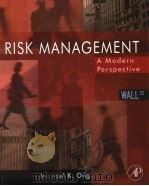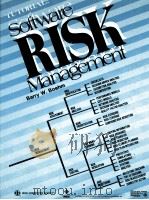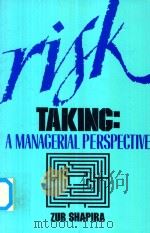《RISK MANAGEMENT A MODERN PERSPECTIVE》
| 作者 | MICHAEL K. ONG 编者 |
|---|---|
| 出版 | 未查询到或未知 |
| 参考页数 | 739 |
| 出版时间 | 没有确切时间的资料 目录预览 |
| ISBN号 | 0120884380 — 求助条款 |
| PDF编号 | 811868638(仅供预览,未存储实际文件) |
| 求助格式 | 扫描PDF(若分多册发行,每次仅能受理1册) |

SECTION I Enterprise Risk Management1
1: Managing risk across the enterprise : challenges and benefits3
I Risk Management in Context4
II Value Proposition ERM6
III ERM Framework and Implementation10
IV Key Challenges and Issues15
V The Future for ERM16
2: Asset and liability management from an enterprise-wide risk management perspective21
I Learning the Hard way: Breaking down Barriers in Risk Management Functions22
II The Jarrow-Merton Put Option as a Comprehensive Measure of Total Risk24
III Extracting Business Risk and Default Risk from Options Prices: The Citigroup Example25
IV Total Risk As Measured by Reduced Form Credit Models33
V Enhancing ALM’s Contribution to Integrated Risk Management36
SVI ummary and Conclusions37
3: Enterprise risk management in the energy and power industry41
I Introduction42
II Observations on the Energy and Power Market Landscape44
III Modeling and Measurement Methodologies,Benchmarks,and Objectives49
IV Restoration of Confidence and solidification of Risk Management Practices56
4: ERM strategies for investors59
I Introduction60
II ERM Goes Mainstream60
III ERM Strategies for Investors61
IV Sucessful ERM for Investors62
V Current challenges in ERM for Investors64
SECTION II Risk Optimization67
5: Risk budgeting as a strategic tool for pension plans69
I What is Risk Budgeting?70
II the Risk Budgeting Process for Pension Plans72
III The Tools of Risk Budgeting74
IV Conclusions82
6: Advanced risk budgeting techniques89
I Introduction90
II What is Risk Budgeting?91
III Risk Attribution97
IV Risk Alocation100
V Extensions and New Developments105
7: Hedge fund investing113
I Introduction114
Investing for Absolute Returns: From Beta to alpha116
III Salient Features and Myths118
IV The Risk Manager’s Roadmap to Paradigm Pitfalls123
V Sharper RAPMs for the New Paradigm: From Omega to AORAP132
VI Paradigm Risk Measures135
VII Asset Allocation and Hedge funds139
VIII Conclusions141
8: The hedge fund paradigm145
I Introduction146
II Hedge funds Biotope,Regulatory Environment,and Fee Structure148
III Hedge Fund Styles151
IV Measuring and Managing Hedge Fund Risks158
V Conclusions177
SECTION III Risk Modeling181
9: Retrospective assessment of value at risk183
I Introduction184
II Model Risk184
III Back-Testing VaR Models188
IV Conclusions201
10: New challenges in credit risk modeling and measurement203
I Introduction204
II Risk types205
III Credit Demand: Products and Modeling Issues210
IV Defining Key Credit Concepts220
V Modeling Corporate credit225
11: Estimating parameters required for credit risk modeling235
I Introduction236
II Default Risk237
III Exposure at Default242
IV Loss Given Default245
V Correlations249
12: Determining loss given default and transaction ratings in collateralized lending with obligor-collateral correlation253
I Introduction and Motivation254
II Expected Loss as a Put Option256
III The Model258
IV Model Inputs and Parameters262
V Using the Expected LGD to Obtain Transaction Rating264
VI Calibrationg267
VII Risk Sensitivities269
VIII Conclusions270
IX Addendum: Calculation of K271
13: Modeling correlation risk273
I Introduction274
II The Link Between the Interest Rate Swap Spread and time-Varying Correlation274
III An Empirical Model of time-Varying Correlations278
IV Conclusions291
14: Developing a framework for operational risk analytics295
I Database Modeling296
II Measuring Operational Risk298
III Framework Integration306
15: An analysis of value and risk : the ProcterGamble-bankers trust case309
I Introduction310
II Literature Review and Our Contribution312
III The 5/30 Option and Associated spreads314
IV Fair Value for Politions in the 5/30 Options and Spreads317
V Market Risk Analysis328
VI Conclusions329
VII Appendix: Margrabe Model Valuation of 5/30 Option331
SECTION IV Risk Integration339
16: Integration of credit and market risk341
I Introduction342
II Top-Down Approach343
III Bottom-Up Approach351
IV Volatile Exposure355
V Exact formulation359
VI Dependency Concepts360
VII Further Extensions361
VIII Conclusions363
17: Mathematical framework for integrating market and credit risk367
I Introduction368
II Risk Measures369
III Market and Credit Risk373
IV Regulatory Environment379
V risk Management383
VI Conclusions386
Appendix: Transition and Generator Matrix388
18: Integration of operational risk management and the Sarbanes-Oxley act section 404391
I Introduction392
II Sarbanes-Oxley Act of 2002393
III Sarbanes-Oxley section 404394
IV COSO Internal Control Integrated Framework395
V Sarbanes-Oxley roles and responsibilities398
VI Operationa risk Management Framework400
VII Operationa risk Management Roles and Responsibilities401
VIII Common Elements of Sarbanes-Oxley Act Section 404 and Operational Risk Management404
IX Technology as an Enabler407
Conclusions: Benefits of an Integrated approach410
SECTION V Capital Allocation413
19: Capital allocation using risk management tools415
I Introduction416
II From Book Capital to Risk Capital416
III Conceptual Definition of Economic Capital417
IV Economic Capital as a Departure from Standard Corporate Finance419
V Modeling of Risk as a Prerequisite for Appropriate Economic Capital Allocation: What Are the types of Risk to be Modeled?422
VI Broad Types of Economic Capital Models425
VII Capital Allocation to Business Units427
IX Risk-Adjusted Performance: Economic Capital and Shareholdr Value Creation428
X economic Capital As the cornerstone of Enterprise Risk Management430
20: Risk capital attribution and risk-adjusted performance measurement433
I What Purpose does Risk Capital Serve?434
II Emerging Uses of Risk Capital Numbers435
III RAROC Risk-Adjusted Return on Capital437
IV RAROC in Practice450
V Conclusions453
21: Aligning regulatory capital with economic capital455
I Introduction456
II Role of Regulatory Capital Requirements459
III Allocating Economic Capital Within a Portfolio of Assets461
IV Aligning the Two: Introduction to Basel II463
V Critical View476
Conclusions478
22: Aligning regulatory with economic capital : an alternative approach to risk weights according to basel II481
I Introduction482
II Asset Correlation484
III Maturity492
IV Diversitfication495
V Flexible Confidence Level500
VI Summary504
SECTION VI Risk Forecasting507
23: Forecasting extreme financial risk509
I Introduction510
II Methods for Modeling extreme risk512
III Overview of EVT Theory515
IV Applying EVT528
V Conclusions535
24: Measuring financial extremes537
I Introduction538
II A Brief,Recent History of Financial Risk Modeling539
III Extreme Value Statistics540
IV Point Processes548
25: The distribution of returns and risk forecasting557
I Introduction558
II A Simple Trading Model560
III A Volatility Forecasting Model563
IV The Return Forecasting Model566
V Risk Forecasting572
VI Conditional Expected Loss578
VII Concluding Comments580
26: Relevance of volatility forecasting in financial risk management583
I Introduction584
II Volatility and Volatility Forecast585
III Forecasting Volatility with Daily data592
IV Forecasting Volatility with High-Frequency Data593
V Volatility Processes595
VI An Empirical Comparison of the Forecasts599
VII conclusions602
27: The evolution of risk reporting607
I Introduction608
II Financial Risk609
III From Monolithi9c Risk Reporting Entities to Decomposed Risky Portfolios609
IV From Risk Exposure Measurement to Financial Risk Measurement610
V From Differential to Stochastic Financial Risk Measures616
VI From Default-Free to Credit-Oriented Risk Exposure Measures624
VII From Current to Future Financial Risk Measures and reporting628
28: Emerging trends in risk reporting633
I Introduction634
II Traditional risk Reporting Framework636
III Changing Role of Risk Management640
IV Regulatory Developments and Demands642
V Quantitative Tools and techniques644
VI Summary Implications for Risk reporting648
VII Conclusions649
SECTION VIII Bebavioral finance and Compensation System651
29: The role of behavioral finance in risk management653
I Intriduction654
II How Do People Perceive Risks?656
III How do People Perceive Probabilities?657
IV How do Investors Perceive Equity risk?658
VI How do Investors Perceive the Relationship Between Risk and Return?659
VII What Factors Determine People’s Attitudes Tjoward Risk?660
VIII How Important is Framing?663
IX What is Regret?664
XI How does Affect Cause Preference Reversal?665
XII How do Fear and Hope Influence Risk Tolerance?666
XIII How do Fear and Hope Influence Judgments About Value?671
XIV How do Investors Measure the Risk/Return Trade-off?672
XV How Effective ar Groups at Making Decisions?672
XVI Examples of Psychologically Induced Errors674
XVII Is Debiasing Possible?675
XVIII Conclusions675
30: "Buy on the rumor" and "sell on the news"677
In Introduction679
II BRSN Examples681
III BRSN Theory685
IV Complexity in the Markets685
V Collective Behavior and Market Anomalies687
VII Self-Regulation of Behavior689
VIII Affect and Decision Making691
IX Anticipation, Expectation, and Affect692
X Anticipation of Reward: BRSN Stage I693
XI Revelation: BRSN STAGEII695
XII Disappointment: BRSN STAGEIII697
XIII Event selection698
XIV Discussion698
31: Aligning compensation systems with risk management objectives703
I Introduction704
II Operational Risk, Farley’s Law, and Behavior705
III A typical Trading Desk Criteria Control System706
IV Generalized Problems with Objective systems706
V Dynamics of Authority Influence and the Impact on Risk708
High-Profile Misalignments of Incentives and Objectives709
VII The Perfect Storm: Joseph Jett and Kidder Peabody711
VIII The Role of the Risk Manager713
IX Mapping Employee Desired Behavior718
X The Risk Manager’s Dilemma720
XI Conclusions721
Index723
《RISK MANAGEMENT A MODERN PERSPECTIVE》由于是年代较久的资料都绝版了,几乎不可能购买到实物。如果大家为了学习确实需要,可向博主求助其电子版PDF文件。对合法合规的求助,我会当即受理并将下载地址发送给你。
高度相关资料
-

- SOFTWARE RISK MANAGEMENT
- 1989 IEEE COMPUTER SOCIETY PRESS
-

- RISK TAKING:A MANAGERIAL PERSPECTIVE
- 1995 RUSSELL SAGE FOUNDATION
-

- MODERN MANAGEMENT OF HIGH RISK PREGNANCY
- 1983 PLENUM MEDICAL BOOK COMPANY
-

- Risk Taking A Managerial Perspective
- 1995 Russell Sage Foundation
-

- Human resource management a managerial perspective
- 1999 International Thomson Business Press
-

- MODERN MANAGEMENT OF HIGH RISK PREGNANCY
- 1983 PLENUM MEDICAL BOOK COMANY
-

- MODERN INDONESIA TRADITION & TRANSFORMATION A Socio-Historical Perspective
- 1984 GADJAH MADA UNIVERSITY PRESS
-

- MODERN INDONESIA TRADITION & TRANSFORMATION A SOCIO-HISTORICAL PERSPECTIVE
- 1988 GADJAH MADA UNIVERSITY PRESS
-

- MANAGEMENT INFORMATION SYSTEMS A CONTEMPORARY PERSPECTIVE SECOND EDITION
- 1991 MACMILLAN PUBLISHING COMPANY
-

- FINANCIAL INSTITUTIONS MANAGEMENT A MODERN PERSPECTIVE SECOND EDITION
- 1997 IRWIN/MCGRAW-HILL
-

- OPERATING SYSTEMS A MODERN PERSPECTIVE
- 1997 ADDISON-WESLEY
-

- BUDDHISM:A MODERN PERSPECTIVE
- 1975 PENNSYLVANIA STATE UNIVERSITY
提示:百度云已更名为百度网盘(百度盘),天翼云盘、微盘下载地址……暂未提供。➥ PDF文字可复制化或转WORD


